Drug Addiction and the Concept of Common Good
VerifiedAdded on 2022/12/29
|8
|2046
|62
AI Summary
This essay critiques the global issue of drug addiction in relation to the concept of common good and proposes ways to address the challenge.
Contribute Materials
Your contribution can guide someone’s learning journey. Share your
documents today.
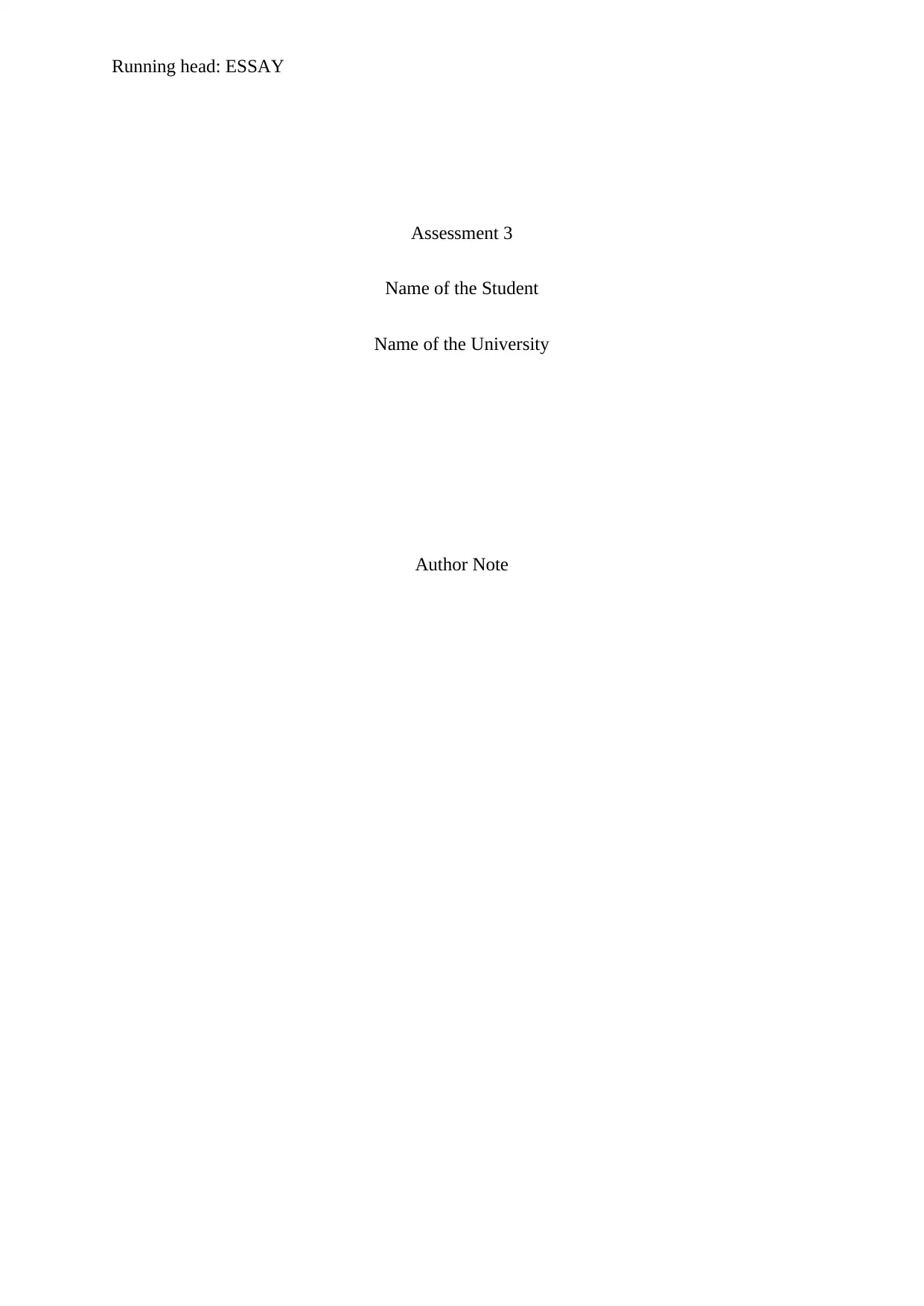
Running head: ESSAY
Assessment 3
Name of the Student
Name of the University
Author Note
Assessment 3
Name of the Student
Name of the University
Author Note
Secure Best Marks with AI Grader
Need help grading? Try our AI Grader for instant feedback on your assignments.
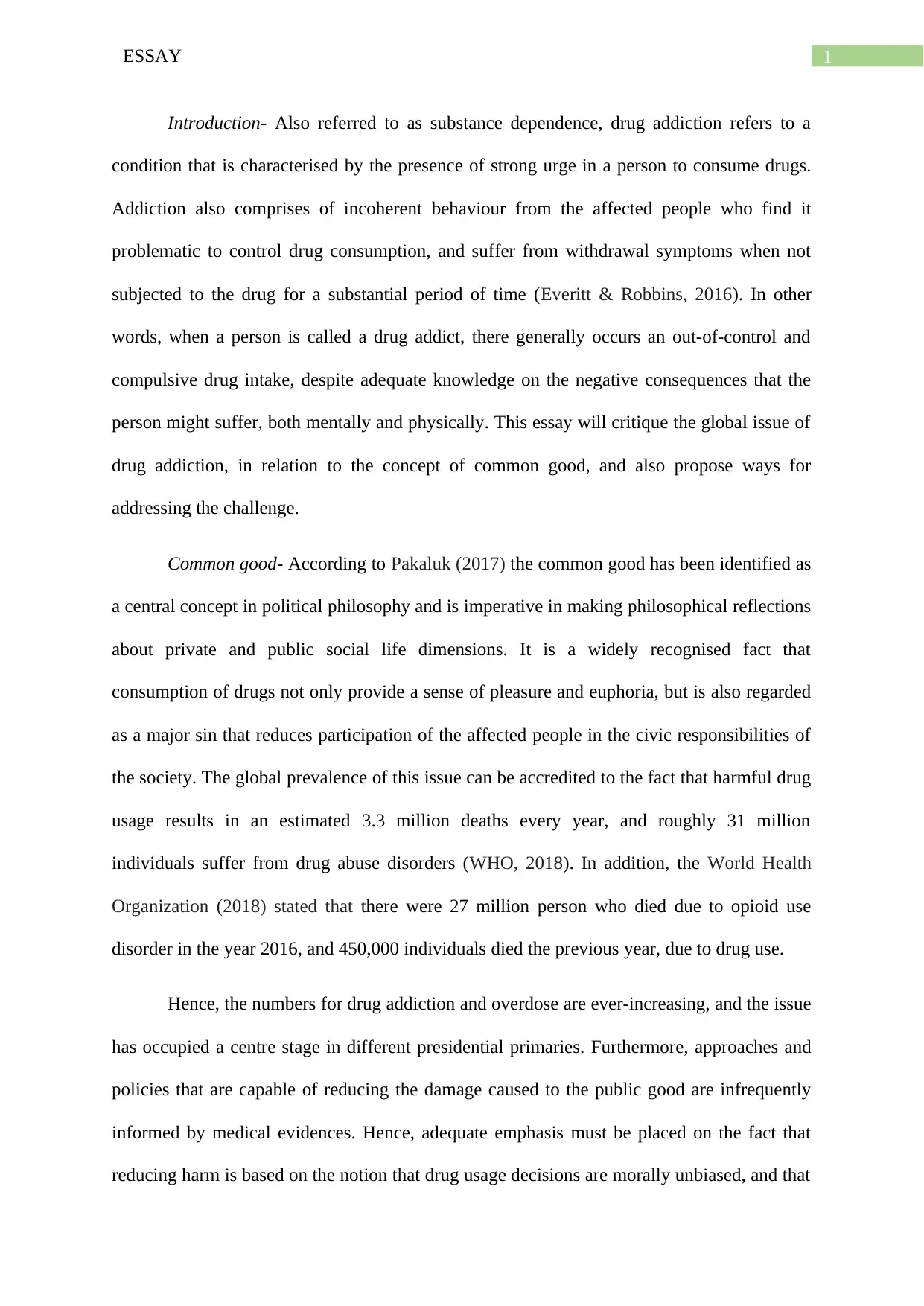
1ESSAY
Introduction- Also referred to as substance dependence, drug addiction refers to a
condition that is characterised by the presence of strong urge in a person to consume drugs.
Addiction also comprises of incoherent behaviour from the affected people who find it
problematic to control drug consumption, and suffer from withdrawal symptoms when not
subjected to the drug for a substantial period of time (Everitt & Robbins, 2016). In other
words, when a person is called a drug addict, there generally occurs an out-of-control and
compulsive drug intake, despite adequate knowledge on the negative consequences that the
person might suffer, both mentally and physically. This essay will critique the global issue of
drug addiction, in relation to the concept of common good, and also propose ways for
addressing the challenge.
Common good- According to Pakaluk (2017) the common good has been identified as
a central concept in political philosophy and is imperative in making philosophical reflections
about private and public social life dimensions. It is a widely recognised fact that
consumption of drugs not only provide a sense of pleasure and euphoria, but is also regarded
as a major sin that reduces participation of the affected people in the civic responsibilities of
the society. The global prevalence of this issue can be accredited to the fact that harmful drug
usage results in an estimated 3.3 million deaths every year, and roughly 31 million
individuals suffer from drug abuse disorders (WHO, 2018). In addition, the World Health
Organization (2018) stated that there were 27 million person who died due to opioid use
disorder in the year 2016, and 450,000 individuals died the previous year, due to drug use.
Hence, the numbers for drug addiction and overdose are ever-increasing, and the issue
has occupied a centre stage in different presidential primaries. Furthermore, approaches and
policies that are capable of reducing the damage caused to the public good are infrequently
informed by medical evidences. Hence, adequate emphasis must be placed on the fact that
reducing harm is based on the notion that drug usage decisions are morally unbiased, and that
Introduction- Also referred to as substance dependence, drug addiction refers to a
condition that is characterised by the presence of strong urge in a person to consume drugs.
Addiction also comprises of incoherent behaviour from the affected people who find it
problematic to control drug consumption, and suffer from withdrawal symptoms when not
subjected to the drug for a substantial period of time (Everitt & Robbins, 2016). In other
words, when a person is called a drug addict, there generally occurs an out-of-control and
compulsive drug intake, despite adequate knowledge on the negative consequences that the
person might suffer, both mentally and physically. This essay will critique the global issue of
drug addiction, in relation to the concept of common good, and also propose ways for
addressing the challenge.
Common good- According to Pakaluk (2017) the common good has been identified as
a central concept in political philosophy and is imperative in making philosophical reflections
about private and public social life dimensions. It is a widely recognised fact that
consumption of drugs not only provide a sense of pleasure and euphoria, but is also regarded
as a major sin that reduces participation of the affected people in the civic responsibilities of
the society. The global prevalence of this issue can be accredited to the fact that harmful drug
usage results in an estimated 3.3 million deaths every year, and roughly 31 million
individuals suffer from drug abuse disorders (WHO, 2018). In addition, the World Health
Organization (2018) stated that there were 27 million person who died due to opioid use
disorder in the year 2016, and 450,000 individuals died the previous year, due to drug use.
Hence, the numbers for drug addiction and overdose are ever-increasing, and the issue
has occupied a centre stage in different presidential primaries. Furthermore, approaches and
policies that are capable of reducing the damage caused to the public good are infrequently
informed by medical evidences. Hence, adequate emphasis must be placed on the fact that
reducing harm is based on the notion that drug usage decisions are morally unbiased, and that
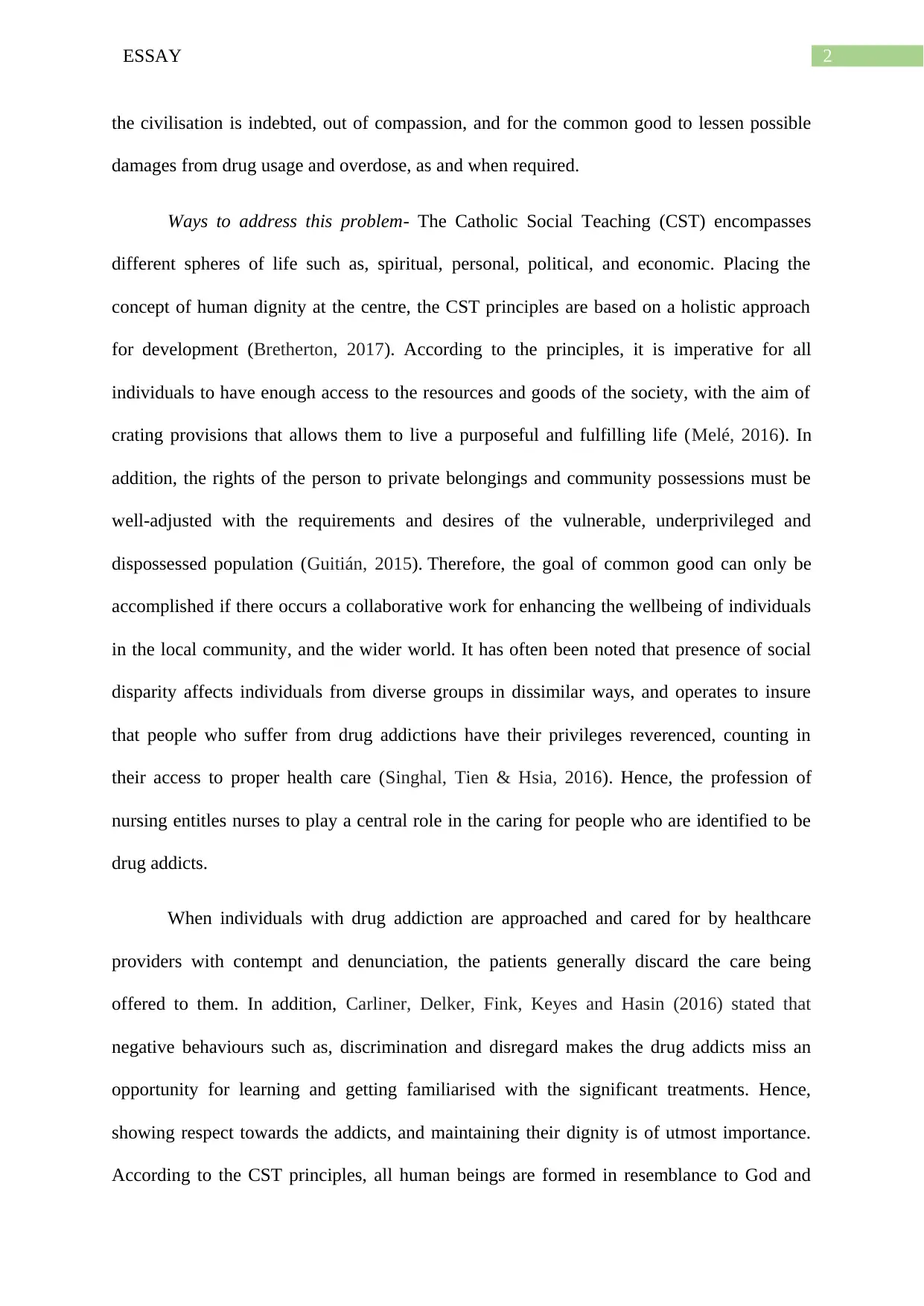
2ESSAY
the civilisation is indebted, out of compassion, and for the common good to lessen possible
damages from drug usage and overdose, as and when required.
Ways to address this problem- The Catholic Social Teaching (CST) encompasses
different spheres of life such as, spiritual, personal, political, and economic. Placing the
concept of human dignity at the centre, the CST principles are based on a holistic approach
for development (Bretherton, 2017). According to the principles, it is imperative for all
individuals to have enough access to the resources and goods of the society, with the aim of
crating provisions that allows them to live a purposeful and fulfilling life (Melé, 2016). In
addition, the rights of the person to private belongings and community possessions must be
well-adjusted with the requirements and desires of the vulnerable, underprivileged and
dispossessed population (Guitián, 2015). Therefore, the goal of common good can only be
accomplished if there occurs a collaborative work for enhancing the wellbeing of individuals
in the local community, and the wider world. It has often been noted that presence of social
disparity affects individuals from diverse groups in dissimilar ways, and operates to insure
that people who suffer from drug addictions have their privileges reverenced, counting in
their access to proper health care (Singhal, Tien & Hsia, 2016). Hence, the profession of
nursing entitles nurses to play a central role in the caring for people who are identified to be
drug addicts.
When individuals with drug addiction are approached and cared for by healthcare
providers with contempt and denunciation, the patients generally discard the care being
offered to them. In addition, Carliner, Delker, Fink, Keyes and Hasin (2016) stated that
negative behaviours such as, discrimination and disregard makes the drug addicts miss an
opportunity for learning and getting familiarised with the significant treatments. Hence,
showing respect towards the addicts, and maintaining their dignity is of utmost importance.
According to the CST principles, all human beings are formed in resemblance to God and
the civilisation is indebted, out of compassion, and for the common good to lessen possible
damages from drug usage and overdose, as and when required.
Ways to address this problem- The Catholic Social Teaching (CST) encompasses
different spheres of life such as, spiritual, personal, political, and economic. Placing the
concept of human dignity at the centre, the CST principles are based on a holistic approach
for development (Bretherton, 2017). According to the principles, it is imperative for all
individuals to have enough access to the resources and goods of the society, with the aim of
crating provisions that allows them to live a purposeful and fulfilling life (Melé, 2016). In
addition, the rights of the person to private belongings and community possessions must be
well-adjusted with the requirements and desires of the vulnerable, underprivileged and
dispossessed population (Guitián, 2015). Therefore, the goal of common good can only be
accomplished if there occurs a collaborative work for enhancing the wellbeing of individuals
in the local community, and the wider world. It has often been noted that presence of social
disparity affects individuals from diverse groups in dissimilar ways, and operates to insure
that people who suffer from drug addictions have their privileges reverenced, counting in
their access to proper health care (Singhal, Tien & Hsia, 2016). Hence, the profession of
nursing entitles nurses to play a central role in the caring for people who are identified to be
drug addicts.
When individuals with drug addiction are approached and cared for by healthcare
providers with contempt and denunciation, the patients generally discard the care being
offered to them. In addition, Carliner, Delker, Fink, Keyes and Hasin (2016) stated that
negative behaviours such as, discrimination and disregard makes the drug addicts miss an
opportunity for learning and getting familiarised with the significant treatments. Hence,
showing respect towards the addicts, and maintaining their dignity is of utmost importance.
According to the CST principles, all human beings are formed in resemblance to God and
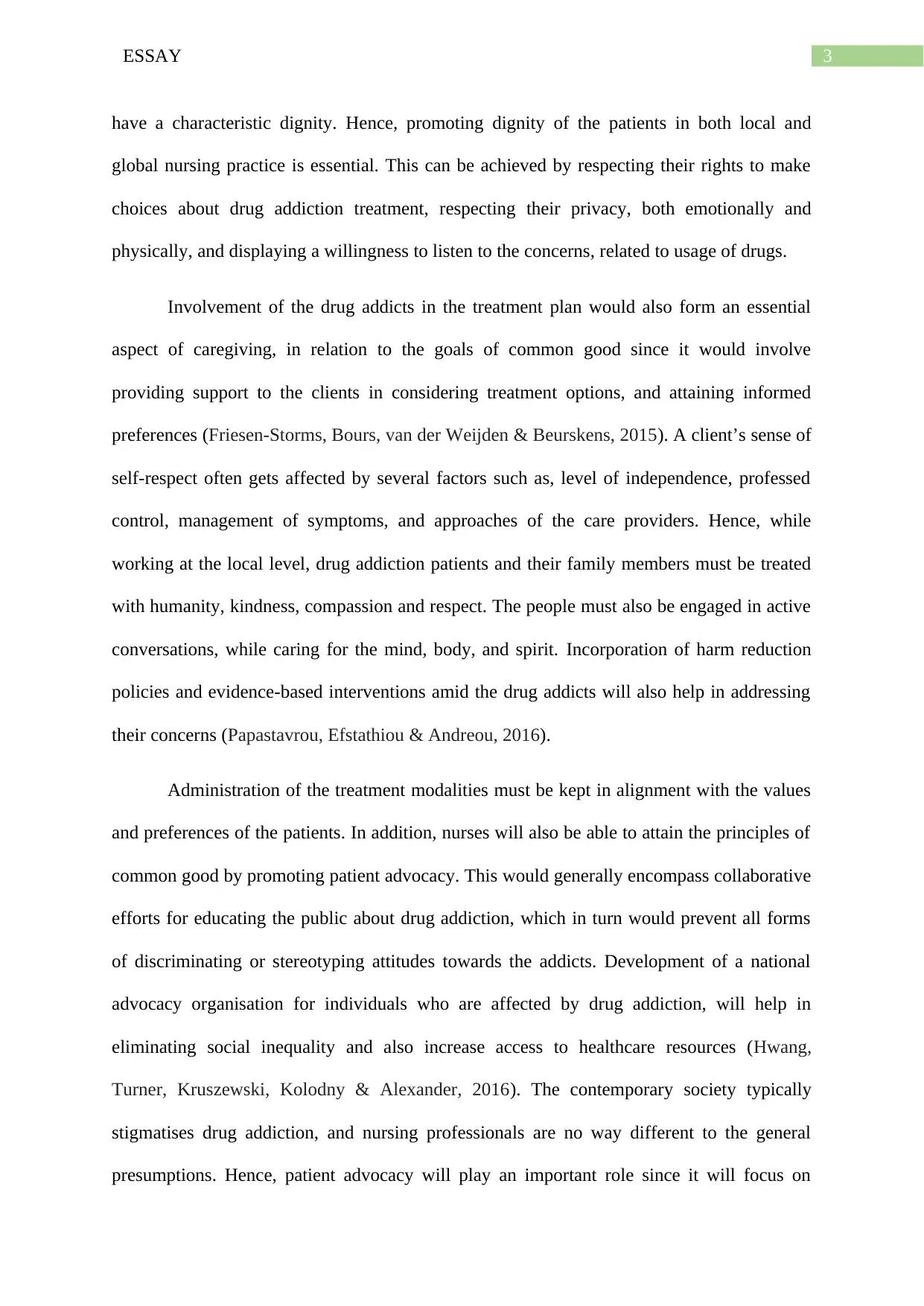
3ESSAY
have a characteristic dignity. Hence, promoting dignity of the patients in both local and
global nursing practice is essential. This can be achieved by respecting their rights to make
choices about drug addiction treatment, respecting their privacy, both emotionally and
physically, and displaying a willingness to listen to the concerns, related to usage of drugs.
Involvement of the drug addicts in the treatment plan would also form an essential
aspect of caregiving, in relation to the goals of common good since it would involve
providing support to the clients in considering treatment options, and attaining informed
preferences (Friesen-Storms, Bours, van der Weijden & Beurskens, 2015). A client’s sense of
self-respect often gets affected by several factors such as, level of independence, professed
control, management of symptoms, and approaches of the care providers. Hence, while
working at the local level, drug addiction patients and their family members must be treated
with humanity, kindness, compassion and respect. The people must also be engaged in active
conversations, while caring for the mind, body, and spirit. Incorporation of harm reduction
policies and evidence-based interventions amid the drug addicts will also help in addressing
their concerns (Papastavrou, Efstathiou & Andreou, 2016).
Administration of the treatment modalities must be kept in alignment with the values
and preferences of the patients. In addition, nurses will also be able to attain the principles of
common good by promoting patient advocacy. This would generally encompass collaborative
efforts for educating the public about drug addiction, which in turn would prevent all forms
of discriminating or stereotyping attitudes towards the addicts. Development of a national
advocacy organisation for individuals who are affected by drug addiction, will help in
eliminating social inequality and also increase access to healthcare resources (Hwang,
Turner, Kruszewski, Kolodny & Alexander, 2016). The contemporary society typically
stigmatises drug addiction, and nursing professionals are no way different to the general
presumptions. Hence, patient advocacy will play an important role since it will focus on
have a characteristic dignity. Hence, promoting dignity of the patients in both local and
global nursing practice is essential. This can be achieved by respecting their rights to make
choices about drug addiction treatment, respecting their privacy, both emotionally and
physically, and displaying a willingness to listen to the concerns, related to usage of drugs.
Involvement of the drug addicts in the treatment plan would also form an essential
aspect of caregiving, in relation to the goals of common good since it would involve
providing support to the clients in considering treatment options, and attaining informed
preferences (Friesen-Storms, Bours, van der Weijden & Beurskens, 2015). A client’s sense of
self-respect often gets affected by several factors such as, level of independence, professed
control, management of symptoms, and approaches of the care providers. Hence, while
working at the local level, drug addiction patients and their family members must be treated
with humanity, kindness, compassion and respect. The people must also be engaged in active
conversations, while caring for the mind, body, and spirit. Incorporation of harm reduction
policies and evidence-based interventions amid the drug addicts will also help in addressing
their concerns (Papastavrou, Efstathiou & Andreou, 2016).
Administration of the treatment modalities must be kept in alignment with the values
and preferences of the patients. In addition, nurses will also be able to attain the principles of
common good by promoting patient advocacy. This would generally encompass collaborative
efforts for educating the public about drug addiction, which in turn would prevent all forms
of discriminating or stereotyping attitudes towards the addicts. Development of a national
advocacy organisation for individuals who are affected by drug addiction, will help in
eliminating social inequality and also increase access to healthcare resources (Hwang,
Turner, Kruszewski, Kolodny & Alexander, 2016). The contemporary society typically
stigmatises drug addiction, and nursing professionals are no way different to the general
presumptions. Hence, patient advocacy will play an important role since it will focus on
Secure Best Marks with AI Grader
Need help grading? Try our AI Grader for instant feedback on your assignments.
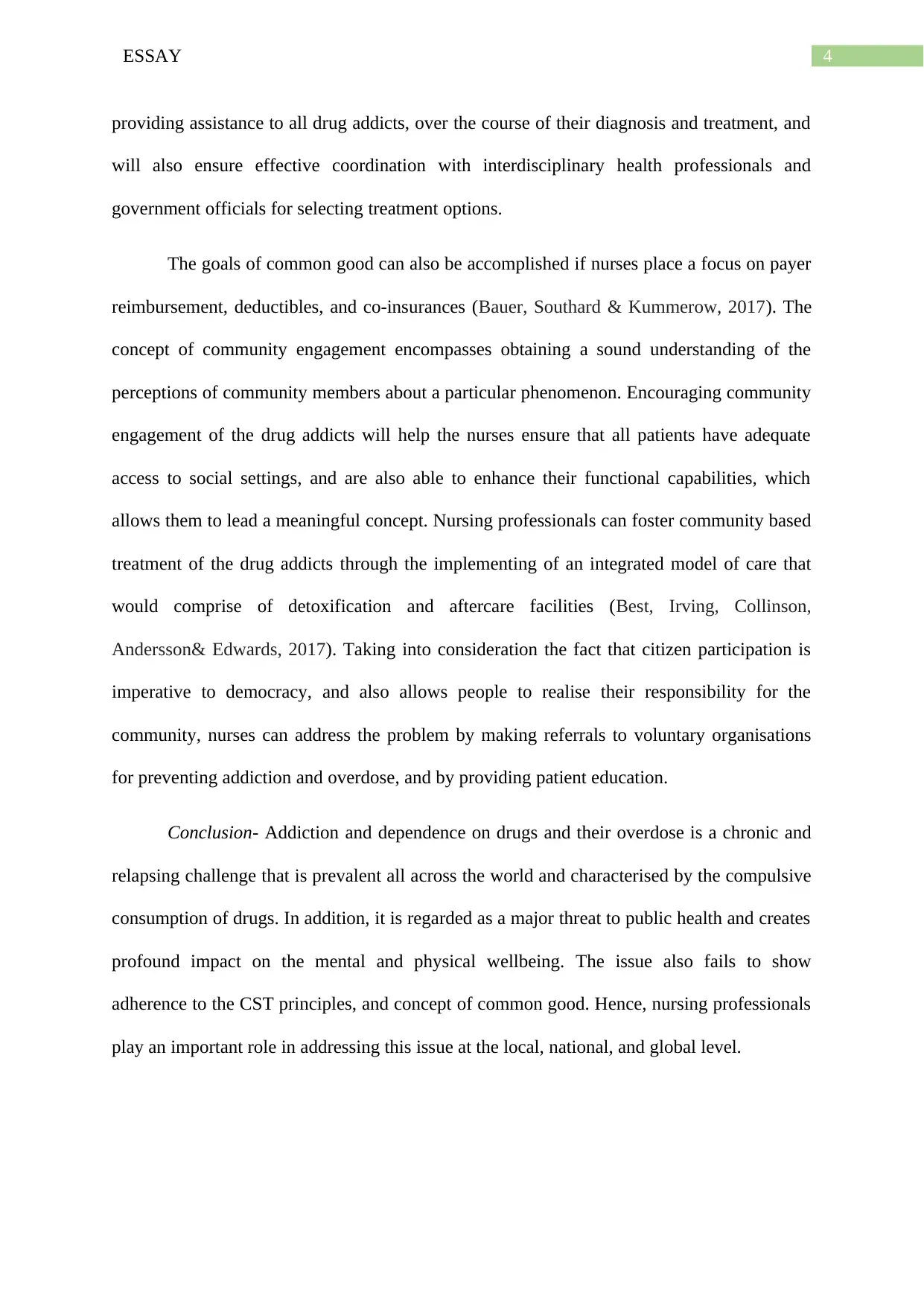
4ESSAY
providing assistance to all drug addicts, over the course of their diagnosis and treatment, and
will also ensure effective coordination with interdisciplinary health professionals and
government officials for selecting treatment options.
The goals of common good can also be accomplished if nurses place a focus on payer
reimbursement, deductibles, and co-insurances (Bauer, Southard & Kummerow, 2017). The
concept of community engagement encompasses obtaining a sound understanding of the
perceptions of community members about a particular phenomenon. Encouraging community
engagement of the drug addicts will help the nurses ensure that all patients have adequate
access to social settings, and are also able to enhance their functional capabilities, which
allows them to lead a meaningful concept. Nursing professionals can foster community based
treatment of the drug addicts through the implementing of an integrated model of care that
would comprise of detoxification and aftercare facilities (Best, Irving, Collinson,
Andersson& Edwards, 2017). Taking into consideration the fact that citizen participation is
imperative to democracy, and also allows people to realise their responsibility for the
community, nurses can address the problem by making referrals to voluntary organisations
for preventing addiction and overdose, and by providing patient education.
Conclusion- Addiction and dependence on drugs and their overdose is a chronic and
relapsing challenge that is prevalent all across the world and characterised by the compulsive
consumption of drugs. In addition, it is regarded as a major threat to public health and creates
profound impact on the mental and physical wellbeing. The issue also fails to show
adherence to the CST principles, and concept of common good. Hence, nursing professionals
play an important role in addressing this issue at the local, national, and global level.
providing assistance to all drug addicts, over the course of their diagnosis and treatment, and
will also ensure effective coordination with interdisciplinary health professionals and
government officials for selecting treatment options.
The goals of common good can also be accomplished if nurses place a focus on payer
reimbursement, deductibles, and co-insurances (Bauer, Southard & Kummerow, 2017). The
concept of community engagement encompasses obtaining a sound understanding of the
perceptions of community members about a particular phenomenon. Encouraging community
engagement of the drug addicts will help the nurses ensure that all patients have adequate
access to social settings, and are also able to enhance their functional capabilities, which
allows them to lead a meaningful concept. Nursing professionals can foster community based
treatment of the drug addicts through the implementing of an integrated model of care that
would comprise of detoxification and aftercare facilities (Best, Irving, Collinson,
Andersson& Edwards, 2017). Taking into consideration the fact that citizen participation is
imperative to democracy, and also allows people to realise their responsibility for the
community, nurses can address the problem by making referrals to voluntary organisations
for preventing addiction and overdose, and by providing patient education.
Conclusion- Addiction and dependence on drugs and their overdose is a chronic and
relapsing challenge that is prevalent all across the world and characterised by the compulsive
consumption of drugs. In addition, it is regarded as a major threat to public health and creates
profound impact on the mental and physical wellbeing. The issue also fails to show
adherence to the CST principles, and concept of common good. Hence, nursing professionals
play an important role in addressing this issue at the local, national, and global level.
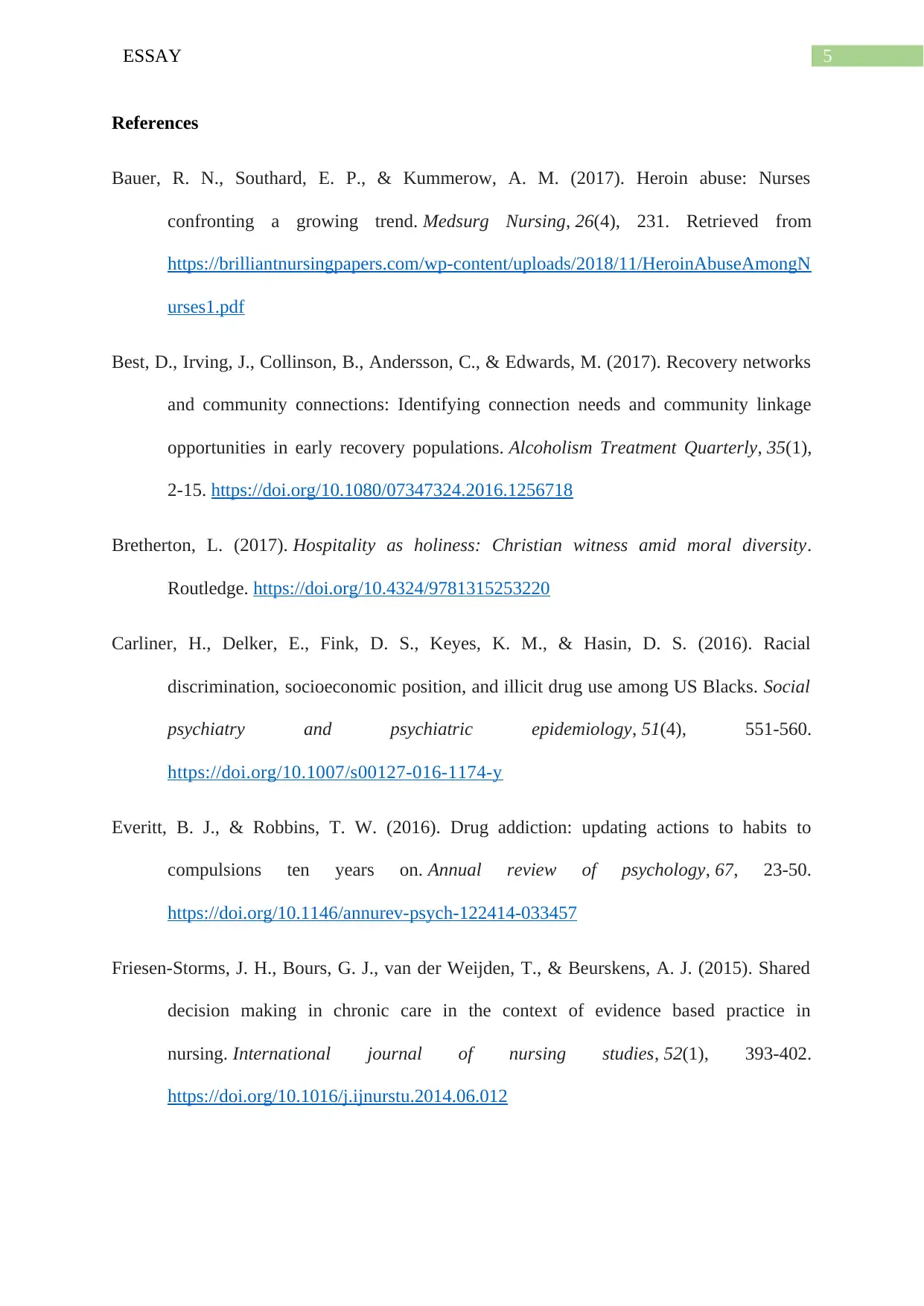
5ESSAY
References
Bauer, R. N., Southard, E. P., & Kummerow, A. M. (2017). Heroin abuse: Nurses
confronting a growing trend. Medsurg Nursing, 26(4), 231. Retrieved from
https://brilliantnursingpapers.com/wp-content/uploads/2018/11/HeroinAbuseAmongN
urses1.pdf
Best, D., Irving, J., Collinson, B., Andersson, C., & Edwards, M. (2017). Recovery networks
and community connections: Identifying connection needs and community linkage
opportunities in early recovery populations. Alcoholism Treatment Quarterly, 35(1),
2-15. https://doi.org/10.1080/07347324.2016.1256718
Bretherton, L. (2017). Hospitality as holiness: Christian witness amid moral diversity.
Routledge. https://doi.org/10.4324/9781315253220
Carliner, H., Delker, E., Fink, D. S., Keyes, K. M., & Hasin, D. S. (2016). Racial
discrimination, socioeconomic position, and illicit drug use among US Blacks. Social
psychiatry and psychiatric epidemiology, 51(4), 551-560.
https://doi.org/10.1007/s00127-016-1174-y
Everitt, B. J., & Robbins, T. W. (2016). Drug addiction: updating actions to habits to
compulsions ten years on. Annual review of psychology, 67, 23-50.
https://doi.org/10.1146/annurev-psych-122414-033457
Friesen-Storms, J. H., Bours, G. J., van der Weijden, T., & Beurskens, A. J. (2015). Shared
decision making in chronic care in the context of evidence based practice in
nursing. International journal of nursing studies, 52(1), 393-402.
https://doi.org/10.1016/j.ijnurstu.2014.06.012
References
Bauer, R. N., Southard, E. P., & Kummerow, A. M. (2017). Heroin abuse: Nurses
confronting a growing trend. Medsurg Nursing, 26(4), 231. Retrieved from
https://brilliantnursingpapers.com/wp-content/uploads/2018/11/HeroinAbuseAmongN
urses1.pdf
Best, D., Irving, J., Collinson, B., Andersson, C., & Edwards, M. (2017). Recovery networks
and community connections: Identifying connection needs and community linkage
opportunities in early recovery populations. Alcoholism Treatment Quarterly, 35(1),
2-15. https://doi.org/10.1080/07347324.2016.1256718
Bretherton, L. (2017). Hospitality as holiness: Christian witness amid moral diversity.
Routledge. https://doi.org/10.4324/9781315253220
Carliner, H., Delker, E., Fink, D. S., Keyes, K. M., & Hasin, D. S. (2016). Racial
discrimination, socioeconomic position, and illicit drug use among US Blacks. Social
psychiatry and psychiatric epidemiology, 51(4), 551-560.
https://doi.org/10.1007/s00127-016-1174-y
Everitt, B. J., & Robbins, T. W. (2016). Drug addiction: updating actions to habits to
compulsions ten years on. Annual review of psychology, 67, 23-50.
https://doi.org/10.1146/annurev-psych-122414-033457
Friesen-Storms, J. H., Bours, G. J., van der Weijden, T., & Beurskens, A. J. (2015). Shared
decision making in chronic care in the context of evidence based practice in
nursing. International journal of nursing studies, 52(1), 393-402.
https://doi.org/10.1016/j.ijnurstu.2014.06.012
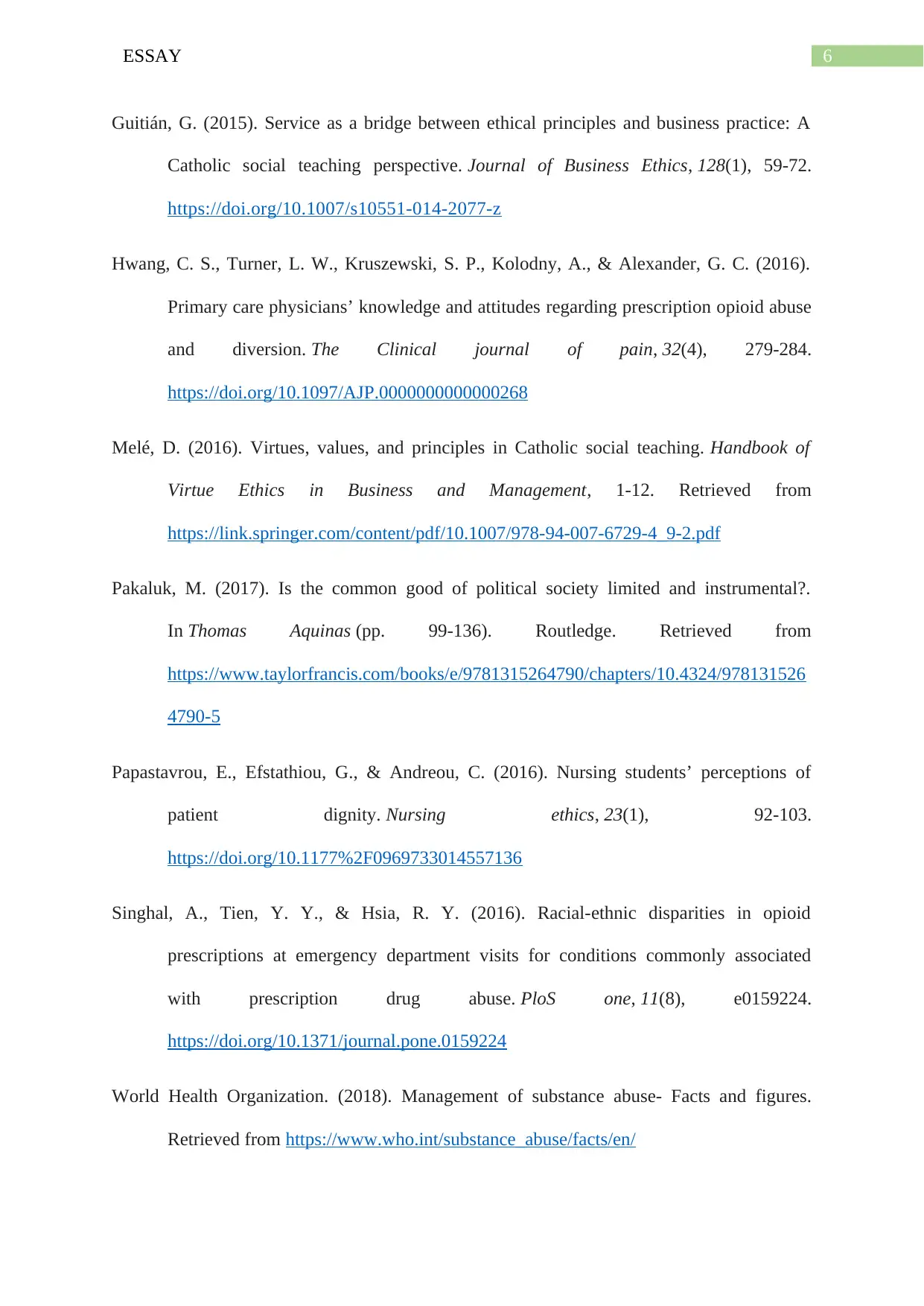
6ESSAY
Guitián, G. (2015). Service as a bridge between ethical principles and business practice: A
Catholic social teaching perspective. Journal of Business Ethics, 128(1), 59-72.
https://doi.org/10.1007/s10551-014-2077-z
Hwang, C. S., Turner, L. W., Kruszewski, S. P., Kolodny, A., & Alexander, G. C. (2016).
Primary care physicians’ knowledge and attitudes regarding prescription opioid abuse
and diversion. The Clinical journal of pain, 32(4), 279-284.
https://doi.org/10.1097/AJP.0000000000000268
Melé, D. (2016). Virtues, values, and principles in Catholic social teaching. Handbook of
Virtue Ethics in Business and Management, 1-12. Retrieved from
https://link.springer.com/content/pdf/10.1007/978-94-007-6729-4_9-2.pdf
Pakaluk, M. (2017). Is the common good of political society limited and instrumental?.
In Thomas Aquinas (pp. 99-136). Routledge. Retrieved from
https://www.taylorfrancis.com/books/e/9781315264790/chapters/10.4324/978131526
4790-5
Papastavrou, E., Efstathiou, G., & Andreou, C. (2016). Nursing students’ perceptions of
patient dignity. Nursing ethics, 23(1), 92-103.
https://doi.org/10.1177%2F0969733014557136
Singhal, A., Tien, Y. Y., & Hsia, R. Y. (2016). Racial-ethnic disparities in opioid
prescriptions at emergency department visits for conditions commonly associated
with prescription drug abuse. PloS one, 11(8), e0159224.
https://doi.org/10.1371/journal.pone.0159224
World Health Organization. (2018). Management of substance abuse- Facts and figures.
Retrieved from https://www.who.int/substance_abuse/facts/en/
Guitián, G. (2015). Service as a bridge between ethical principles and business practice: A
Catholic social teaching perspective. Journal of Business Ethics, 128(1), 59-72.
https://doi.org/10.1007/s10551-014-2077-z
Hwang, C. S., Turner, L. W., Kruszewski, S. P., Kolodny, A., & Alexander, G. C. (2016).
Primary care physicians’ knowledge and attitudes regarding prescription opioid abuse
and diversion. The Clinical journal of pain, 32(4), 279-284.
https://doi.org/10.1097/AJP.0000000000000268
Melé, D. (2016). Virtues, values, and principles in Catholic social teaching. Handbook of
Virtue Ethics in Business and Management, 1-12. Retrieved from
https://link.springer.com/content/pdf/10.1007/978-94-007-6729-4_9-2.pdf
Pakaluk, M. (2017). Is the common good of political society limited and instrumental?.
In Thomas Aquinas (pp. 99-136). Routledge. Retrieved from
https://www.taylorfrancis.com/books/e/9781315264790/chapters/10.4324/978131526
4790-5
Papastavrou, E., Efstathiou, G., & Andreou, C. (2016). Nursing students’ perceptions of
patient dignity. Nursing ethics, 23(1), 92-103.
https://doi.org/10.1177%2F0969733014557136
Singhal, A., Tien, Y. Y., & Hsia, R. Y. (2016). Racial-ethnic disparities in opioid
prescriptions at emergency department visits for conditions commonly associated
with prescription drug abuse. PloS one, 11(8), e0159224.
https://doi.org/10.1371/journal.pone.0159224
World Health Organization. (2018). Management of substance abuse- Facts and figures.
Retrieved from https://www.who.int/substance_abuse/facts/en/
Paraphrase This Document
Need a fresh take? Get an instant paraphrase of this document with our AI Paraphraser
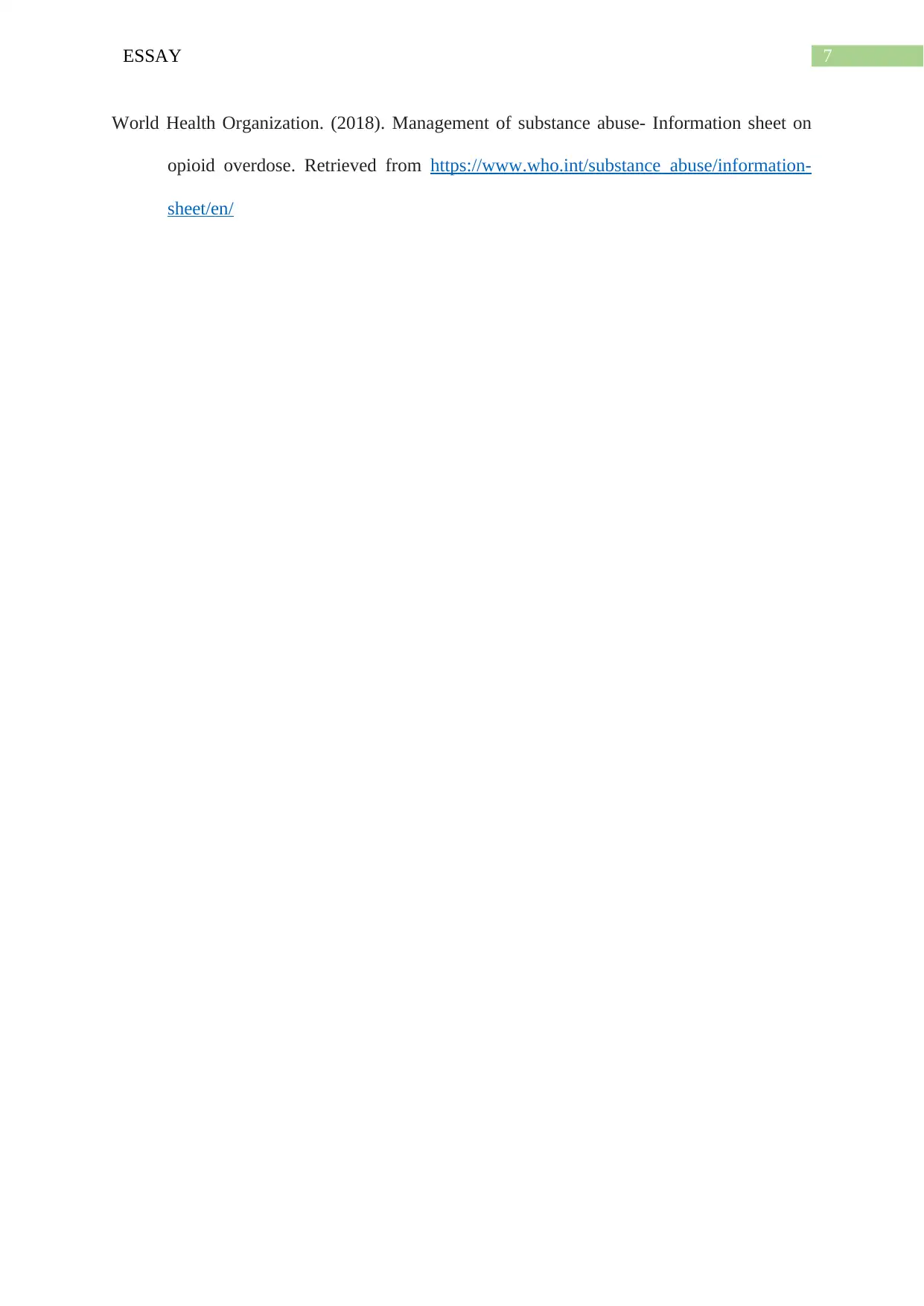
7ESSAY
World Health Organization. (2018). Management of substance abuse- Information sheet on
opioid overdose. Retrieved from https://www.who.int/substance_abuse/information-
sheet/en/
World Health Organization. (2018). Management of substance abuse- Information sheet on
opioid overdose. Retrieved from https://www.who.int/substance_abuse/information-
sheet/en/
1 out of 8
Your All-in-One AI-Powered Toolkit for Academic Success.
+13062052269
info@desklib.com
Available 24*7 on WhatsApp / Email
![[object Object]](/_next/static/media/star-bottom.7253800d.svg)
Unlock your academic potential
© 2024 | Zucol Services PVT LTD | All rights reserved.

